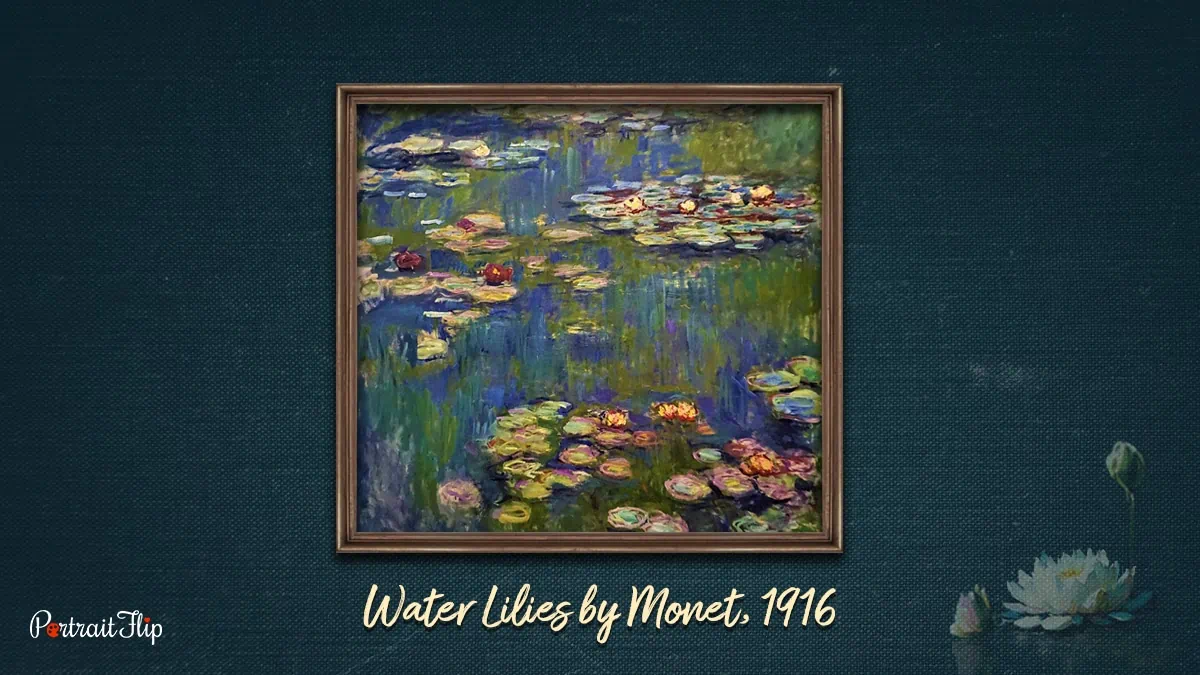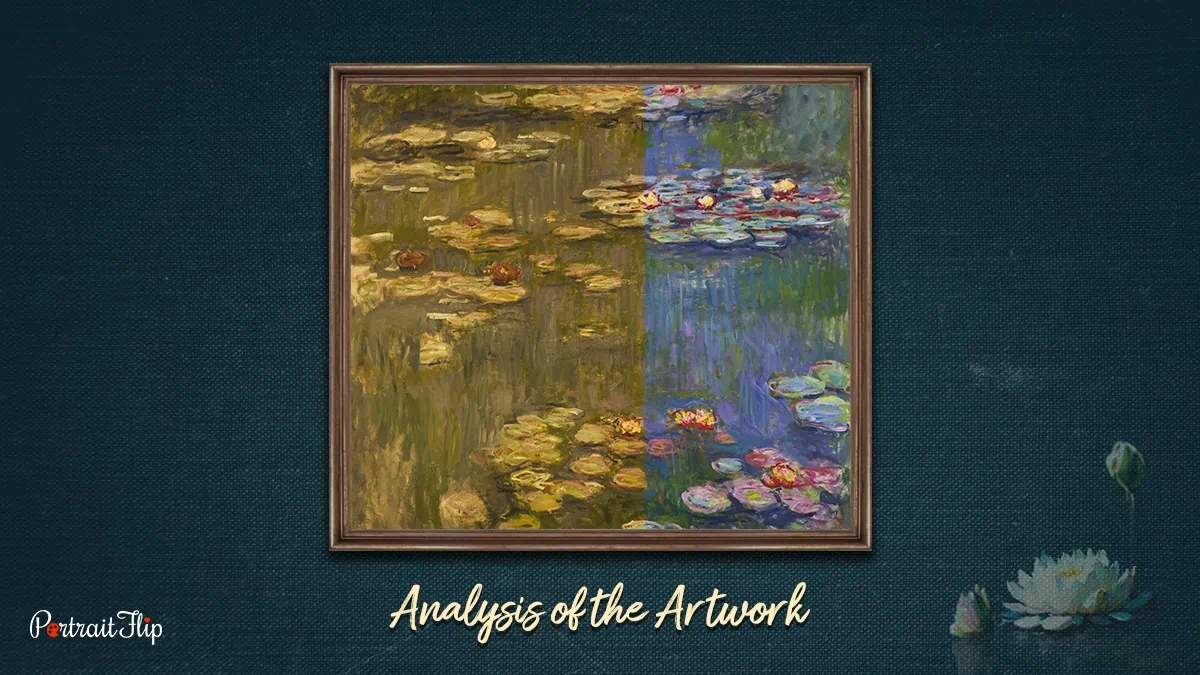Table of contents
Art, artists, and their disabilities! Which, to your surprise, never stopped them from creating some of the most mesmerizing masterpieces.
The same was the case with Claude Monet, one of the most famous painters of the 19th century, who, with time, was on the verge of losing his vision.
Yet, he created one of his most decorated art series, “Water Lilies,” or “Nymphéas” in French.
What clicks in your mind when you hear about Water Lilies by Monet?
Pond, beautiful flowers, etc.?
Paintings by Claude Monet made him famous, despite them being artworks from his last thirty years of life.
He created a series of paintings that featured over 270 artworks of the pond of lilies he grew back at his home in Giverny.
So, without further ado, let us jump right into The Water Lilies by Claude Monet.
Suggested Read: The Last Supper by Leonardo da Vinci
About Claude Monet

An impressionist painter born on November 14, 1847, Claude Monet was interested in art from childhood.
He founded the impressionist painting style and also acted as a stepping stone for modernism.
His full name was Oscar-Claude Monet, and he was one of the most famous French painters.
He was a man of wisdom who was inspired by Impressionists artists like Edouard Manet and Pissarro.
With his artistic vision, he believed that he could get whatever he wanted.
Claude Monet’s paintings are some of the most complex yet structured paintings in the impressionist movement.
His life was like a rollercoaster ride, whenever he grew closer to someone, they unfortunately left.
Whether it be his mother, his wife, or his aunt, they were all some of his biggest supporters in life and in his art career.
He consistently practiced the philosophies of impressionism in his paintings, and he loved to express his perception of nature, which he especially applied in his landscape paintings.
But, as it is said, good things don’t last forever. His eyesight started getting worse after sometime
That’s the reason why he literally purchased land in Giverny and planted lilies in the water pond.
With this being said, it is also a fact that Claude Monet never really intended to focus on anything other than his lilies when he moved to Giverny.
But amid this all, he lived his last years of life with pride and curated some of the finest paintings in that phase.
Among the best-known examples are his series of haystacks (1890–91), paintings of the Rouen Cathedral (1894), and the paintings of water lilies, which were made in his garden in Giverny that occupied him continuously for the last 30 years of his life.
Suggested Read: Impression, Sunrise by Claude Monet
Water Lilies: The Series

The most talked about series of artworks in the history of painting is Monet’s Water Lilies.
It consists of approximately 250 oil paintings that were curated with patience by the art prodigy, and that too in the backyard of his home in Giverny.
Water Lilies by Monet was one of the artist’s greatest achievements in his life, and it also became an inspiration for many artists around the world.
Even though Monet’s vision started getting worse due to cataracts, he focused on praising the beauty of nature with his brush.
His artistic approach towards the pond of Lilies and his love for nature started growing in the year 1889; that’s when the commencement of the series of Water Lilies by Monet took place.
During the time he was living on the outskirts of London, he started selling his paintings and hired two servants and one gardener to take care of and cultivate his garden back in Giverny.
Monet proudly said that whatever he earned, it all went into planting the garden.
Suggested Read: Sunflowers by Vincent Van Gogh
Water Lilies by Monet, 1916

“It took me time to understand my waterlilies. I had planted them for the pleasure of it; I grew them without ever thinking of painting them.”
-Claude Monet
In 1916, Monet decided to build a large studio measuring 23 m by 12m at Giverny.
This painting is one of the most intricate compositions by Claude Monet, as he has painted the flowers of lilies and water streams delicately.
He focused more on clouds, the reflection on the water surfaces, and the textures of colors that added beautiful effects to the painting.
This is not all of it; Claude would sit for hours and hours just so that he could complete the artwork.
Monet’s first water lily series was executed between 1897 and 1899. This initial round of painting yielded the most traditional results.
Claude Monet also experimented with colors, and his palette signified the same.
Claude Monet did a very good job in terms of adding the structures and also in expressing the message that he wanted to share during the difficult times of World War I.
This version of the painting can be seen in the National Museum of Western Art, Tokyo.
It is definitely one of the most beautiful paintings from the series of Water Lilies by Monet.
And what if I told you that you could own a copy of this painting, and that too of museum quality?
You sure would be surprised to know that we can get it done for you, and that too at affordable prices!
Hang it in your living room or on your balcony to give your place a quirky feel.
To know more about how you can get a replica of Water Lilies by Monet, 1916:
The Composition of the Painting

Water Lilies by Monet is said to be one of the finest works of art in the history of Impressionism.
It took over 25 years for Monet to complete over 250 oil paintings on small and large canvases.
Some canvases are as big as the walls of a museum.
Despite being partially blind and suffering from cataracts, the passionate painter Claude Monet could not hold his creativity back and started painting.
Every artwork in this series is hand-painted by Monet himself, and he has beautifully represented his love for nature and flowers in the painting.
If you look closely, you can also see that Claude has focused on the clouds, the surface of the water, and the lily pads on which the flowers are floating.
You can also see varied styles of brush-strokes and accumulations of colors all at once that denote the flowers of lilies.
The leaves, bushes, and trees nearby are also intricately painted by Monet, but most of them are in monotonous hues.
Amid facing many losses and downfalls in life, Claude Monet kept his chin up and drew his art from the bottom of his heart.
Suggested Read: Famous Baroque Artists
Analysis of the Artwork

It is a fact that there is no other work of art that is more distinctive than the Water Lilies by Monet, or, as in French, Les Nympheas.
The French word Nymphea originates from the Greek word numphe, which literally means nymph.
This hails from the Classical myth that attributes the birth of the flower to a nymph who was desperate for the love of Hercules.
If you closely inspect the series of paintings, you can see that Claude Monet has painted the whole series in a common hue and warmer tones.
As he was partially blind and already suffering from cataracts, his condition made it hard for him to identify the cooler tones of colors.
So whenever he started to paint, the grains of color would be more dominant in the warmer tones, which led him to use more pastel and yellowish shades of color.
Out of his 300 oil paintings, 40 were large-scale and made on bigger panels by him, which took him years and years of hard work to complete.
Best way to describe the series of Water Lilies by Monet is as “the illusion of an endless hole of water without horizon or bank.”
That is the reason why he painted large panels that were meant to be kept side-by-side to give a complete view of Monet’s vision.
His ever famous large-scaled panels are being displayed in New York’s Metropolitan Museum of Art.
Suggested Art: Post Impressionist Artists
Decorated Artwork by Claude

This beautiful and serene series by Claude Monet represents the calmness and joy of nature.
Water Lilies by Monet was a phenomenal work of art that made its way to some of the most prestigious museums in the world.
He has used mixtures of tranquil colors, bright hues and perfect symbolism in his paintings to represent the aura he lived in.
It was in 1914 that the painter decided to put all his energies into producing his great decoration.
The famous water lily pond inspired Monet to create a colossal work composed of almost 300 paintings, over 40 of which were large format.
During the 30 years of his painting cycle, Monet spent endless hours in his area of inspiration, which was his garden of Water Lilies.
It was surprising to many viewers that Claude spent over 30 years of his life painting, and he still kept one and only one title to each of the paintings he created, i.e., Water Lilies.
Water Lilies by Monet was one of the most iconic paintings of Impressionism, along with Starry Night by Vincent Van Gogh.
Most of his panels and artworks during the era of Water Lilies can be witnessed at the Musée de l’Orangerie, Paris.
Suggested Read: Picasso’s The Old Guitarist
Conclusion

This was about the series of paintings by Claude Monet named Water Lilies.
In this art series, Monet has described his journey through cataracts and the fear of almost losing his sight.
He started the painting process at a very fast pace, but after a while, he slowed down when he started drawing panels.
But after all, his hard work and years of efforts finally paid off, and that resulted in his series of Water Lilies being a true inspiration for artists around the world.
Author’s Note
Thank you so much for reading our article on water lilies by Monet!
I am glad that you stayed and read this article about “Water Lilies by Monet,” a series of paintings by Claude Monet.
So, with this being said, I would like to request that you share this blog as much as you can and also leave your valuable feedback in the comments section.
We thrive on bringing new things in-store for you, and we are glad that we are able to provide you with the same.
To know more about what’s new at PortraitFlip, make sure that you follow us on our social media accounts: Instagram, YouTube, and Pinterest.
Meanwhile, take care, folks!
See ya!
Suggested Read: The Persistence of Memory
Suggested Read: Bal du Moulin De La Galette
Suggested Read: Composition 8 by Wassily Kandinsky
FAQs
Water Lilies by Monet is a famous series of paintings, as it took 30 years of effort and more than 250 oil paintings that Claude Monet painted while he was partially blinded by cataracts.
Water Lilies by Claude Monet, version 1916, is housed in the National Museum of Western Art, Tokyo.
Claude Monet was a passionate artist who was equally interested in horticulture. He purchased land in Giverny with a pond nearby. He then proceeded to build a beautiful garden of Water Lilies and he especially hired assistants to help him maintain the garden.
Water Lilies by Monet is a series of oil paintings that consists of more than 250 artworks, and the whole series is an exemplary work of impressionism.





